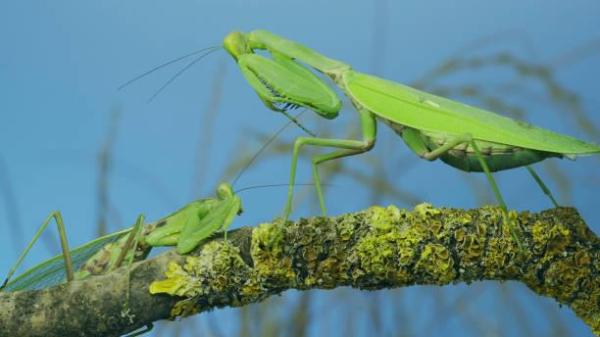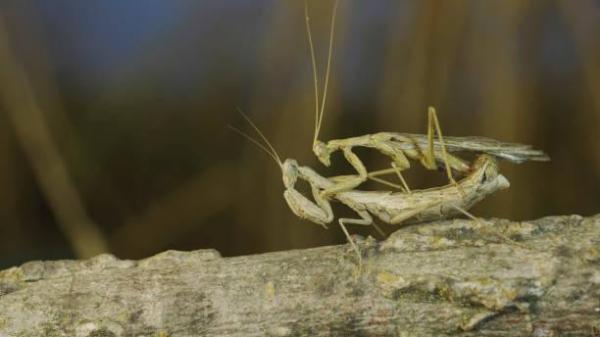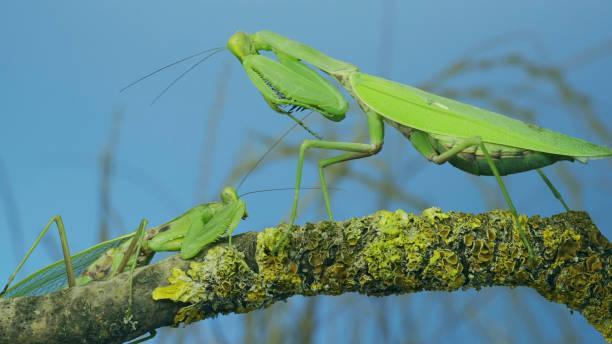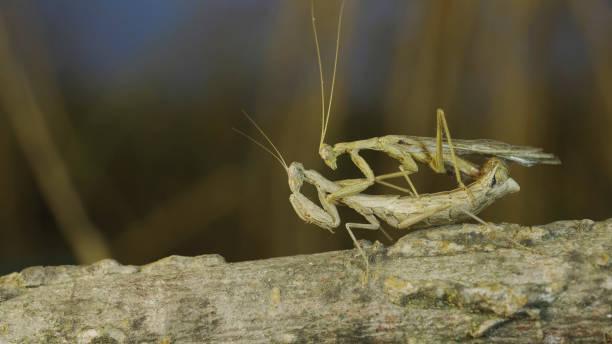How Do Praying Mantises Reproduce?


Picture a creature equipped with lightning-fast reflexes, razor-sharp claws, and an insatiable appetite. Meet the praying mantis, a captivating and formidable predator in the insect realm. Praying mantises are renowned for their intricate and distinctive reproductive process, including the intriguing phenomenon of sexual cannibalism, where the female occasionally consumes her mate post-mating.
In this AnimalWised article, we will guide you through the intricate stages of the praying mantis reproductive cycle, encompassing mating, egg-laying, and nymph development, shedding light on their fascinating world of reproduction.
Courtship of the praying mantis
The courtship of praying mantises is a fascinating and often elaborate process. It varies somewhat among different species, but generally follows a similar pattern.
The first step is for the male to find a female. He uses his keen eyesight to detect her presence, often by spotting her pheromones or movements. Once he identifies a female, he cautiously approaches her. Males typically approach from the front or the side to minimize the risk of being mistaken for prey and attacked.
Many species of mantises engage in courtship displays to signal their intentions to the female. These displays can involve various movements, postures, and sometimes even visual cues like displaying colorful wings or appendages.
In some species, the male presents the female with a gift, usually a prey item such as an insect. This gift serves both as a token of courtship and as a distraction, as the female may be more focused on consuming the gift than attacking the male.
Once the female is receptive to the male's advances, he will climb onto her back and begin to mate.
Curious if praying mantises are poisonous? Find out in this other article.

How do praying mantises mate?
As mentioned in the last section, if the female is receptive, the male will mount her from behind and inseminate her using his specialized sexual organs. Copulation can last from a few minutes to several hours, depending on the species and circumstances.
What do female praying mantis do to their mate?
After copulation, the male and female mantis may separate or remain close for a time. In some species, the male may move away quickly to avoid being eaten by the female. Sexual cannibalism is a behavior that has been observed in some praying mantis species, but it is not universal. The prevalence of sexual cannibalism may depend on factors such as environment and food availability.
Learn more about praying mantis sexual cannibalism in this other article.

How praying mantises lay their eggs
After mating, the female praying mantis becomes gravid, or pregnant. She then searches for a safe place to lay her eggs. She is careful to choose a spot that will protect her offspring and give them the best chance of survival. This could be on a plant stem, twig, leaf, rock, or another surface.
Once she has found a suitable site, the female begins to lay her eggs. Praying mantises don't lay eggs one at a time. Instead, they lay them in clusters inside a protective case called an ootheca. The female uses a special organ called an ovipositor to insert the eggs into the ootheca, along with a secretion that hardens to create a strong shell.
After the female lays her eggs within the protective ootheca, she does not provide any further care or protection to her offspring.
How many eggs does a praying mantis lay?
The number of eggs in an ootheca varies depending on the species, but can range from a few dozen to several hundred.
It is important to note that not all praying mantis eggs survive to become adults. In fact, only a small percentage of eggs typically survive. This is because praying mantis eggs face a number of threats, including:
- Predation: praying mantis eggs are preyed upon by a variety of animals, including birds, lizards, spiders, and other predatory insects.
- Adverse weather conditions: praying mantis eggs can be damaged or destroyed by extreme heat, cold, wind, and rain.
- Disease and parasites: praying mantis eggs can be infected by disease or infested with parasites.
Despite the many challenges they face, praying mantis eggs are surprisingly resilient. The ootheca that protects the eggs is a tough and durable shell that can provide some protection from predators and the elements. Additionally, many species of praying mantises lay their eggs in large clusters, which helps to reduce the risk of predation.
What time of year do praying mantis lay eggs?
Praying mantises usually deposit their eggs in late summer or autumn, with the young developing inside the ootheca throughout the winter season.

How praying mantis nymphs grow and develop?
In the praying mantis life cycle, parents are not involved in the care of their offspring once the eggs are laid. Praying mantises exhibit a type of reproduction called oviparity, which means that the female lays eggs, and the care of the young is left entirely to the environment.
Inside the ootheca, the praying mantis eggs begin their remarkable transformation. In warmer climates, the eggs hatch within a few weeks, but in cooler temperatures, it may take several months.
When the embryos are fully developed, they chew or split open the ootheca to emerge as tiny nymphs. The nymphs are miniature versions of adult mantises, but with pale coloration and soft, vulnerable exoskeletons.
After hatching, the nymphs disperse and immediately begin searching for food. Their diet consists primarily of small insects and other arthropods. As they grow, the nymphs undergo a series of molts, shedding their exoskeletons to accommodate their increasing size.
With each molt, the nymphs' exoskeletons harden, and their coloration becomes more like that of an adult mantis. The number of molts varies depending on the species, but it typically ranges from five to seven instars before the mantis reaches adulthood.
Once the nymphs reach sexual maturity, they have developed into adult mantises capable of mating and reproducing. The lifespan of an adult mantis varies by species, but is generally several months to a year, depending on environmental conditions and predation.
Discover the diverse and fascinating ways other that animals reproduce in this comprehensive article.
If you want to read similar articles to How Do Praying Mantises Reproduce?, we recommend you visit our Facts about the animal kingdom category.
- Barnes, R. D. (1987). Invertebrate zoology (No. Ed. 5). WB Saunders company.
- Kynaston, S.E., McErlain-Ward, P., & Mills, P.J. (1994). Courtship, mating behavior and sexual cannibalism in the praying mantis, Sphodromantis lineola.. Animal Behavior .
- Lelito, J.P., & Brown, W.D. (2008). Mate attraction by females in a sexually cannibalistic praying mantis. Behavioral Ecology and Sociobiology , 63 , 313-320.
- Perez, B. (2005). Calling behavior in the female praying mantis, Hierodula patellifera. Physiological Entomology , 30 (1), 42-47.








